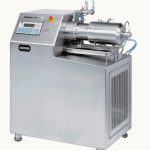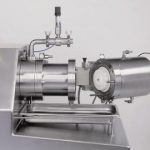A constantly increasing quality consciousness and the general trend towards nanotechnology have significantly sharpened the requirements regarding the reproducibility and particle distribution of grinding and dispersing technology. NPM (Nano Performance Mill) is a circulation ball mill that uses ultra-fine milling beads just 0.05 to 0.1 mm in size to achieve high product quality and efficiency when reducing fine particles to nanoscale.
To meet increasingly high quality requirements, WAB developed the NPM (Nano Performance Mill) based on the well-known grinding concept of the ECM (Efficient Circulation Mill). The heart of the NPM is the Dyno accelerator and a special separating system, which are the essential components for providing dispersion and power efficiency. The distinctive feature of this grinding technology is the way in which energy is transferred to the grinding beads. Whereas all classic bead mills use discs, rotors or pins to apply energy by friction, the accelerators create an intense hydraulic flow of beads and product. This principle facilitates high, uniform and dense energy input with optimal distribution throughout the whole of the grinding chamber. The power of the bead flow is such that a wide range of prod-uct viscosities can be processed at high flow rates without affecting the stability of the beads in the axial direction of the grinding chamber.
In contrast with all other mills, the product is forced individually through each accelerator by the high suction effect (circulation) before it can move on to the next one. Narrow residence times and particle size distributions result. These features allow the ECM to work equally efficiently in single-pass or circulation grinding mode and with high or low product viscosities. The specific energy consumption (kW/kg of product) is between 30 and 60 % that of other grinding systems, depending on the processed product. This underlines the unique efficiency of the process, in which a large percentage of consumed energy is effectively used for grinding. The low energy consumption also has a positive impact on production costs, of course.
The NPM also allows the particle size to be reduced below the defined standard. It is technically possible today to separate grinding beads bigger than 0.2 mm by installing a screen or a gap separator (rotor/stator) at the outlet of the mill. If smaller beads are used, a standard screen could become clogged or a gap separator damaged, depending on the design tolerance. The Nano Performance Mill incorporates a specially developed bead separation system that permits the use of grinding beads smaller than 0.1 mm.
Production of ultra-fine particles
The term nanotechnology covers two major areas. One is a technology for developing new materials with special characteristics by modifying and controlling atoms and molecules, as the unit nanometre is almost identical in size to an atom or a molecule. The other is the technology of wet dispersion in the field of ultra-fine particles (about 10 to 50 nm), which are obtained by a special process that attempts to obtain single particles using very fine grinding beads (<0.1 mm). WAB’s goal is to use grinding beads smaller than 0.1 mm to achieve small particle sizes and improve material performance.
Particle grinding is defined by two main parameters: the stress intensity (kinetic energy of the grinding media) and the number or frequency of stresses (number of grinding media collisions or contact points). Grinding and dispersing can be subdivided into two processing methods: real grinding down to D50 < 0.1 mm is possible using grinding beads 0.3 mm in size. With smaller beads, the particles cannot be ground any further because the stress intensity is insufficient. There is also an intrinsic limit when grinding below 100 nm. Nanoparticles (D50 < 0.04 mm = 40 nm) are very often produced by a chemical process (bottom-up) and subsequently dispersed in a liquid. Small particles have high interaction forces and create agglomerates or aggregates which can only be dispersed with very small grinding beads of less than 0.2 mm. The number of grinding media collisions in the grinding chamber is significant and the key criterion for the break-up of the agglomerates.
The stress intensity and frequency are critical in any dispersion process. Stressing during dispersing can also lead to re-agglomeration. The stressing rate and the contact time are additional parameters. The smaller the particles, the more dominant the interaction forces that lead to agglomeration. For this reason, choosing the optimum parameters for the mill and the product has a vital influence on the success of nanoparticles. The tip speed, filling degree, bead size and density are the most important mill parameters, while the additives, solid content, formulation, pH, etc. determine the product. High impact forces are not necessary to disperse nanomaterials, in other words, because they would produce too much energy and possibly destroy single nanoparticles. Destruction would cause the surface area and the particle energy to increase, leading to a problem with co-agglomeration. Low impact forces and a large number of contact points (ultra-fine beads) are more effective when it comes to dispersing nanomaterials.
Typical application
For a grinding and dispersing trial involving automotive paint, WAB used a finished pigment paste product that was manufactured with 0.5 mm grinding beads in a standard production mill. The Z-average for this product was around 220 nm with a transparency of 5 %. During the grinding cycle with the NPM, the colour of the product changed totally from bright to very dark. The product transparency and particle size were measured downstream of the NPM, which was filled with 0.1 mm grinding beads. The transparency increased to 75 % after milling for 90 minutes and remained stable after further milling. The particle size was reduced accordingly from around 220 to 115 nm. In addition, a linear correlation was observed between transparency and particle size.
The Dyno-Mill NPM is also used in many other applications, such as:
- Release of active ingredients in the pharmaceutical industry
- Production of sunscreen products for cosmetics
- Production of anti-adhesive, corrosion- resistant or self-cleaning coatings
- Inkjet ink
The Dyno-Mill ECM and NPM, featuring the patented Dyno-Accelerator concept, are ideal both for soft milling and for high-energy grinding in nanotechnology applications.
cpp 444
Grinding technology
European Nanobusiness Association
Trade fair NanoEurope 2006
Share:








